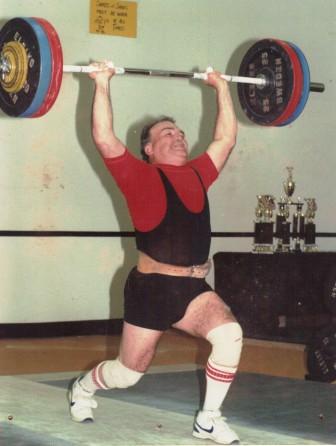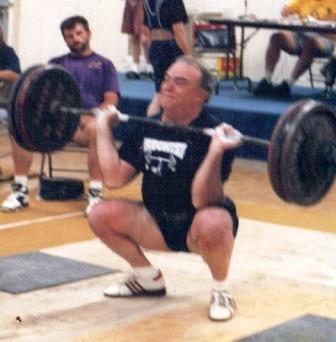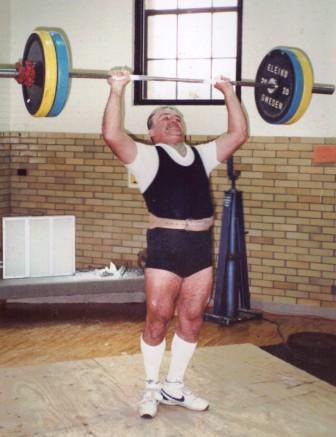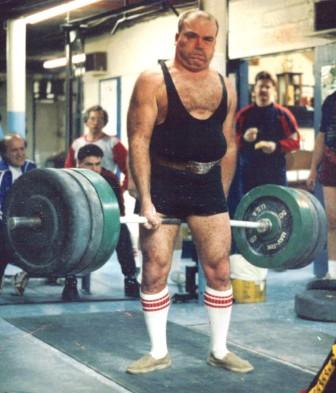Continental Clean and Jerk
by Al Myers

USAWA Hall of Famer Jim Malloy performing a Continental to Chest and Jerk. Or is he doing a Continental Clean and Jerk?
One of the lifts that is going to be contested next November at the 2011 IAWA World Championships in Perth, Australia is the Continental Clean and Jerk. Or is it the Continental to Chest and Jerk, as described in the USAWA Rulebook?? At first glance, one would think these are the same lift, just with different names. I know I did. But in comparing the IAWA(UK) rules for the Continental Clean and Jerk and the USAWA rules for the Continental to Chest and Jerk I found SEVERAL DIFFERENCES. The Continental Clean and Jerk is NOT an USAWA Lift and the Continental to Chest and Jerk is NOT an IAWA lift. I know – that’s confusing!!
The USAWA Rule for the Continental to Chest and Jerk:
A23. Continental to Chest
The lifter starts with the bar on the platform in front of the lifter and raises it by any method of the lifter’s choosing onto the lifter’s chest above the pectoral muscle. The bar may be raised in one or a series of movements and may come to rest, be lowered, or make contact with any part of the legs and body during the lift. However, the bar must not be upended into any position on the body. Hand spacing and grip are of the lifter’s choosing and may be altered on the bar during the lift. The hands may be removed from the bar during the lift. The bar may come to rest on the lifter’s belt. A towel may be placed in the belt for the bar to rest on. Touching the platform with a knee or the buttocks is permissible. It is a disqualification for the bar or plates to touch the platform before the finish of the lift. Once the lifter’s legs are straightened, the lifter’s body erect, the feet parallel and in line with the torso, the bar motionless, an official will give a command to lower the bar. The lift ends when the bar is placed on the platform under control by the lifter.
A24. Continental to Chest and Jerk
The rules of the Continental to Chest apply for the first part of this lift. Once the bar is in the proper position on the chest, a jerk or behind the neck jerk is performed. The rules of the Jerk or Jerk-Behind Neck apply.
The IAWA(UK) Rule for the Continental Clean and Jerk:
B28. CONTINENTAL CLEAN
The bar will be lifted from the floor, coming to rest in the finish position for the clean. The difference between the continental and the regular clean is the fact that it can be raised by any method of the lifters choice, other than upending the bar into position. The bar may be raised in one or a series of movements, it may come to rest, be re-lowered, and make contact with any part of the legs or body during the lift. Touching the lifting surface with any part of the knees or buttocks is permissible. The grip is optional and may be altered during the lift. The signal to replace the bar will be given when the lifter is motionless in the finished clean position, the bar gripped with both hands, body erect, legs braced and feet parallel and in line with the torso. A supportive belt with a folded towel or similar material placed inside it and at the front, may be used to assist the lifter, who may choose to clean the bar from the belt.
Causes for Failure:
1 Allowing the bar to make contact with the lifting surface during the lift.
2 Failure to maintain the finish position, bar on upper chest, legs braced and feet parallel and in line with the torso.
3 Lowering or replacing the bar before the referees signal.
B30. CONTINENTAL CLEAN AND JERK
The rules of performance for the continental clean apply to the clean part of the lift, and the rules of performance for the jerk apply to the jerk part of the lift, except that the jerk can be done from a position in front or behind the neck, it is the lifters choice. There is no limit to the number of attempts made to clean or jerk the bar, once it is lifted from the floor. The lift may also finish with a press out.
Causes for Failure:
1 The causes for failure are the same as for the continental clean, and the jerk, except that it is the lifters choice to jerk from a front or behind the neck position.
After reading these two rule descriptions it is pretty easy to see the differences. The USAWA only applies the use of “continental” to getting the bar to the chest, whereas the IAWA rule allows even the Jerk to be “continentaled”. Taking multiple attempts at the Jerk and allowing a press out (which is a direct rules violation of a Jerk, but then again the use of the term continental to describe a clean is also a direct violation of the definition of a clean) definitely makes the IAWA version of this lift a much easier method than the USAWA version. I might add that the IAWA version definitely will make the judging easier on interpreting the lockout!!!
I’m not interested in debating which is the “correct” rule for this lift. But I will say that these are two distinct different lifts. I just want everyone from the USAWA who plans to compete in next years IAWA Championships to be aware of this before they get there. It seems every year at the World Championships I am presented with a different IAWA rule for a lift that I was not aware of beforehand, because we (the USAWA) have slightly different rules on several lifts. This frustrates me because I consider myself “in the know” on the rulebook. Why do these differences persist? After all, all the rules for the lifts started with ONE WRITTEN RULE in the original rulebook from 1987. The IAWA(UK) developed their rulebook from these rules and the USAWA developed our rulebook from these original rules. As of now, there IS NOT a specific IAWA Rulebook, rather we use the IAWA(UK) Rulebook for the IAWA Rules. Unlike us (the USAWA), the IAWA(UK) have only made changes (besides editing and clarifications) based on membership votes at the IAWA Annual General Meetings, which contains representation of all countries involved in IAWA. We have made changes in the USAWA Rulebook based on membership votes at the USAWA Annual Meetings. The IAWA(UK) have maintained their rulebook this way so ONLY IAWA rules and lifts will be in play in the UK. This is the reason we have lifts in the USAWA that the English do not, as we have approved them at USAWA meetings and these same lifts were turned down (or not presented) at IAWA meetings by membership vote. The IAWA(UK) only accepts new lifts and rule changes into their rulebook that are accepted at the world meetings.
I won’t go into my opinion on these matters, but I hope in the future we will work better together in at least having consistent rules in the individual lifts. I know it will take time to identify and resolve all issues, but at least I feel we are taking steps in the right direction.


